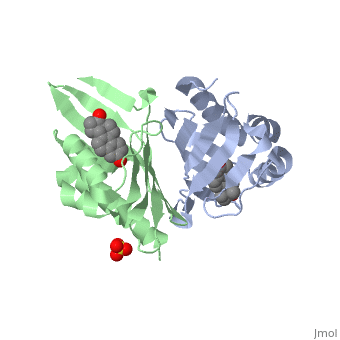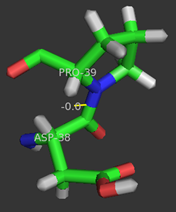Introduction
(KSI, EC#5.3.3.1) or steroid delta-isomerase is an enzyme that catalyzes the isomerization of 3-oxo-Δ5 ketosteroids to their hormonally active Δ4-conjugated isomers, as illustrated below.[1], [2]
This reaction is essential in the biosynthesis of steroids in mammals where KSI is a membrane-bound complex.[3] In bacteria, however, KSI exists as a soluble protein is involves in catabolism of steroids.[3] It was first isolated in and has been extensively studied in Commamonas tetosteroni (TI), a bacteria that is capable of growth with testosterone as its sole carbon source.[4] Structural and kinetic studies of this and its homolog from Pseudomonas putida with which it shares 34% sequence and near identical structural homology.[1],[3] It is one of the most efficient known enzymes with an essentially diffusion limited rate of catalysis.[2],[5] It is capable of increasing the catalytic rate by eleven orders of magnitude.[6] The high degree of efficiency is believed to be due to a preference for the transition state to move towards products rather than reactants although the exact mechanism of this preference is unclear.[1] Its high catalytic efficiency and unique active site geometry have made it fertile ground for examining the validity of the low barrier hydrogen bond hypothesis[7] and electrostatic preorganization.[8]. See also Isomerases.
Structure
Ketosteroid isomerase exits as a 28 kDa homodimeric protein, in which the two dimers related to each other via hydrophobic and electrostatic interactions.[5] Each monomer consists of a curved and three . These secondary structures define a conical closed barrel geometry, with one open and one closed end, and create a deep pocket in which the active site resides.[3],[9] This unique geometry is shared by several other proteins (scytalone dehydratase, nuclear transport factor 2, and naphthalene 1,2-dioxygenase), however, these molecules do not share functional or sequence homology. It is speculated that this unique protein structure may enable better binding of hydrophobic substrates such as steroids.[3]
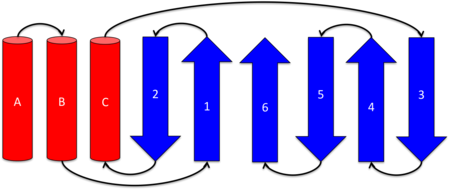
Topology diagram of KSI's structure Helices A, B, and C are in an antiparallel arrangement. The six β-strands form a mixed β-sheet.
Alpha-Helices
Each monomer of KSI contains three α-helices.
is contains residues Thr3 to (N-cap) to Ala20. contains residues Asp22(N-cap) to Phe30. contains residues Thr48 to Leu61. [5]
Alpha-Helix Capping Motifs
α-helix capping motifs are defined by specific patterns of hydrophobic interactions and hydrogen bonding that occur at both the initiation and termination of these secondary structural elements. [10] Capping motifs can also help support the formation of tertiary structural elements. KSI contains examples several of these motifs involved in both C-terminal and N-teminal capping, with two illustrations of C-terminal capping motifs as illustrated below (nomenclature adapted from that of Aurora and Rose [10]):
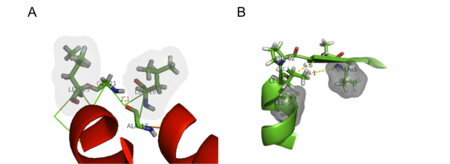
Examples of C-terminal helix capping motifs present in KSI. (A) α-L capping motif. (B) Proline capping motif.
Alpha-L C-terminal capping motif
An α-L C-terminal motif is located at the terminus of helix A (Ala17 to Leu23) and is defined by the following amino acid sequence ALNA-GDLD where Ala20 is in the C-cap position. The α-L motif is stabilized by a hydrogen bond between the backbone carbonyl of Ala17 and the backbone amide hydrogen of Gly21. Furthermore, a hydrophobic interactions between Leu18 and Leu23 adds stability to this structure. The motif is somewhat constrained by the presence of only one residue (Gly21) between helices A and B.
Proline C-terminal capping motif
The presence of a proline at position 62 "breaks" helix C's secondary structure. Leu59 and Val65 form a hydrophobic stable to support this secondary structural element.
Alpha-Helix Packing
Helix B is packed between Helices A and C in a nearly. Helices B and C cross the enzymatically active cavity forming the cavity's "front face."[5]
Beta-Sheet

Type-II β-turn between β-strands 3 and 4. Each monomer of KSI contains a . Strand 1 of the β-sheet is composed of residues Glu43 to Gly47. Strand 2 is contains residues Ala34 to Asp38 and runs antiparallel to strand 1. Leu63 to Val74 make up strand 3 which runs antiparallel to strand 4 (Glu77 to Tyr88). Residues Arg91 to Phe104 and Lys108 to Gly124 form strands 5 and 6 respectively. Strand 5 runs antiparallel to strand 4, while strand 6 runs antiparallel to strand 5 and parallel to strand 1.[5] Each β-sheet contains two β-bulges: and . Both the β-bulges participate in dimer-dimer interactions, potentially leading to their stabilization. The juxtaposition of the two β-bulges on each side of the sheet with a central proline residue creates a substantial in the β-sheet.[5]
Beta-Turns and Loops
β-strand 1 is connected to β-strand 2 via a (Pro39 to Ser42) with Pro39 being in a cis-conformation. Two examples of type-II β-turns can also be observed in KSI-between β-stands 3 & 4 () and β-strands 4 & 5 (). A loop structure () also connects β-strands 5 and 6.
Dimer Interface
The biologically active unit of KSI is a 2-fold symmetric dimer in which the two chains are packed together via hydrophobic and electrostatic interactions between the "back faces" of the β-sheets. The curved β-sheets on each of the monomers expose convex faces to each other, forming well-defined interactions with each monomer having a self-contained active site.[11] In their NMR structure of KSI, Massiah et al. [12] identified interchain hydrophobic interactions (A), as well, a number of polar residues (B) located within the dimer interface.
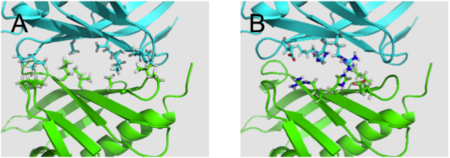
Interactions at KSI's dimer interface (A) Hydrophobic residues. (B) Hydrophillic residues.
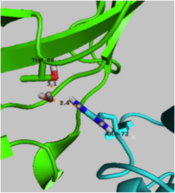
Water mediated dimer interaction between Thr68 and Arg72. In their X-ray crystal structure of KSI, Kim et al.
[13] identified bound water molecules within the dimer interface which may mediate hydrogen-bonds between Thr68, Arg72, and Asp96. The water mediated hydrogen bond between Thr68 and Arg72 is illustrated below. Kim et al. also identified possibe interchain hydrogen bonds between the backbone carbonyl oxygens of Val71, Ala73, and Val97 with the side chains of Asn120, Ser117, and Arg72 respectively based on the solution structure of Wu et al.
[5]. An intersidechain hydrogen-bond is also suspected between His75 and Gln118.
Hydrophobic Active Site
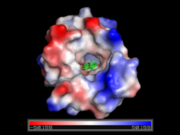
Hydrophobic active site with bound equilenin. KSI's active site is located within a hydrophobic cavity formed helices B and C crossing over the "front face" of the β-sheet that is approximately 8.5 by 9.5 Å at its opening and is 16 Å deep.[5] The cavity is lined with from the β-sheet(Val36, Pro39, Leu63, Val65, Leu67, Val71, Phe80, Phe82, Val84, Val95, Pro97, Phe101, Ala114, and Phe116). contributed from the α-helices include: Val11, Tyr14, Val15, Leu18, Phe54, and Tyr55.[5]
Although the of KSI is notably hydrophobic, it contains several hydrophilic residues believed to be important to the enzymatic function of the protein. The hydrophobic active site of KSI contains an aspartate residue at position 99 and a tyrosine residue at position 14 (according to the numbering for the
Commamonas tetosteroni protein, which will be used throughout) that are capable of forming hydrogen bonds with the 3-position carbonyl of the steroid and form an active site oxyanion hole.
[1],
[14] Additionally, the active site contains an aspartate residue at position 38 that is participates in the catalytic activity of KSI.
[1]
Upon substrate binding the the three α-helices become more tightly packed with the "front face" of the β-sheet. This in turn allows Tyr14 to approach Asp99 and the substrate.
Cis-Peptide Bond
Pro39 of KSI participates in a cis-peptide linkage with Asp38 in forming a between stands 1 and 2 of the 6 stranded beta-sheet.[5] The cis-peptide linkage serves to correctly position the key catalytic residue Asp38 within the active site. Mutating residue to Gly or Ala results in the improper positioning of Asp38 within the active site leading to corresponding 2-fold decreases in enzyme's catalytic efficiency.[15] The cis-peptide bond also helps to stablize and increase the rigidity of the four-residue linkage between β-strands 1 and 2.[15]
Protein Folding
The work of Kim et al. suggests that KSI assembles into its biologically active dimer structure via a multistep pathway.[11] The monomers initially exist in an unfolded configuration (U) with Pro39 in a trans configuration. The monomers then fold into an intermediate configuration that is capable of binding transition state analogs (I). At this stage the native secondary structures have most likely formed, however, it is also likely that hydrophobic residues have been internalized into the core. The tertiary structure formation is most likely promoted by the dimerized intermediate structure (I') before folding to the final native structure. Cis-trans isomerization is the rate-limiting step with dimer structures being formed preferentially from cis-Pro39 monomers.

Protein folding pathway of KSI. (U) Unfolded protein. (I) Monomer intermediate. (I') Dimerized intermediate.
Enzymology
(equinelin; PBD Structure ID 1QJG)
General Mechanism
The general mechanism of the proposed reaction of ketosteroid isomerase involves the breaking of a C-H bond adjacent to a carbonyl. This is typically regarded as a difficult reaction due to instability of the intermediate; however it is observed in a number of enzyme-mediated biological reactions.[1] In line with other biological reactions, the mechanism of KSI involves the abstraction the β-hyrdogen from the 4-position carbon resulting in the formation of an enol intermediate, which is followed by reketonization.[1],[3] Structural and kinetic studies suggest that Asp38 (numbering is that of the TI varient of KSI) serves as a general base in this reaction as shown below and abstracts the β-proton from C4 with the syn orbitals of its carboxylate group.[5] Note the formation of the unstable enolate intermediate.
Tyr14 and Asp99 are believed to participate in hydrogen bonding to the O-3 carbonyl of the substrate steroid and stabilize reaction intermediates. Tyr14 is also believed to participate in a low barrier hydrogen bond with the 3-position oxygen of the steroid, thereby facilitating the abstraction of the β-hydrogen at the 4-position. There are two proposed models of this hydrogen bonding. In , Tyr14 and Asp99 are both bound to the 3-position oxygen, whereas, in , they form a hydrogen bonding network. These are as a single monomer in complex with the intermediate analog equilenin.[16]
Model 1 has become the generally accepted scheme through both crystallographic and mutanagenic/kinetic approaches. Mutation of Asp99 to alanine and Tyr14 to phenylalanine resulted in deleterious effects on kinetic parameters, which were additive in nature suggesting that Tyr14 and Asp99 participate equally in hydrogen binding with the oxygen atom. Additionally, the crystal structure of TI analog from Pseudomonas putida supports this conclusion given the .[1] The general mechanism in the active site of KSI is outlined below.
Low Barrier Hydrogen Bond
Ketosteroid isomerase has become a test enzyme in the debate over the existence of low barrier hydrogen bonds (LBHBs) in accordance with the hydrogen bonding discussed above. Nuclear magnetic resonance (NMR) studies of KSI in complex with transition state analogs have revealed the presence of a highly shielded proton characteristic of the formation of a LBHB between Tyr14 and the O-3 atom of the analogs and suggestive of the formation of a bridging hydrogen with short bonds.[3],[17],[7] Additionally, NMR fractionation studies with deuterium substitution are strongly suggestive of the high strength of this bond as deuterium is retained preferentially in this position.[17] The energy of this bond along with that of the normal hydrogen bond from Asp99 most likely contribute to the energy needed to support proton abstraction from the C-4 position.[3]
LBHB Controversy and Catalytic Efficiency from Preorganized State
In their 2002 computational study Feierberg and Aquist propose that KSI is not the site of LBHB mediated catalysis[18], a viewpoint that is shared among a subset of enzymologists.[19] Hershlag and coworkers are proponents of the hydrogen bonding mechanism described in ;[19],[20] however, he suggests that hydrogen bonding is important within the active site of KSI albeit in the form of multiple weaker forces.[8] Hydrogen bonds and other electrostatic contributions are contended to allow for a degree of preorientation of the active site for transition state stabilization that helps to counter act the effects of desolvation and reorientation of dipoles within the enzyme active site to support the oxyanion hole, which helps to avoid "sluggish" behavior associated with such rearrangement.[1] This type of hydrogen bonding network also helps to disperse negative charge enabling stabilization of the transition state because in the hydrophobic environment of the active site large charges are abhorred.[8]
Implications of Hydrophobic Active Site
In combination with the above mentioned hydrogen bond interactions between the substrate and the active site, the highly hydrophobic active site also serves to stabilize the catalytic efficiency of KSI because it is in a preorganized state compared to the of the reaction carried out in solvent where acetate anion is used to mimic the functionality of Asp38 and has a similar pKaof 4.6 as suggested above. The consequence of this hydrophic active site is that Asp38 has no neighbors capable of hydrogen bonding interactions and as such one may suspect its pKa to raised in this environment. Maintenance of this normal pKa is important because protonation of Asp38 would no longer permit it to carry out hydrogen abstraction. To prevent divergence of Asp38 from its normal pKa during initial substrate binding, it is believe hydrogen bonded to two or three water molecules, as suggested by computer models, which are excluded from the active site later in the enzymatic reaction.[1]
Related Proteins
Functionally Related Proteins
Ketosteroid isomerase is one of a large number of enzymes that catalyze the cleavage of a C-H bond. Among these are mandelate racemace, triosephosphate isomerase, citrate synthase, and 4-oxalocrotonate tautomerase.[1]
Structural Homologs
As noted above, scytalone dehydratase, nuclear transport factor 2 (NTF2), and naphthalene 1,2-dioxygenase share similar structural motifs to ketosteroid isomerase, which facilitate binding of hydrophobic substrates.[3],[6] It has also been postulated that bile acid 7α-dehydratase is also a member of this family of protein and that it shares functional similarity with KSI.[6] In a recent paper, Cherney et al[21]. identified Myobacterium tuberculosis Rv0760c as a structural homolog of KSI. Although these proteins share similar structural motifs there carry out a diverse array of functions.[21]
Structural Classifications
CATH
KSI is classified using the CATH classification system as follows:
- Class - Alpha Beta
- Architecture - Roll
- Topology - Nuclear Transport Factor 2
SCOP
KSI is classified using the SCOP classification system as follows:
- Class - Alpha and Beta (α+β)
- Fold - Cystatin-like
- Superfamily - NTF2-like
- Family - Ketosteroid Isomserase-like
- Domian - Δ5-3-ketosteroid isomerase
